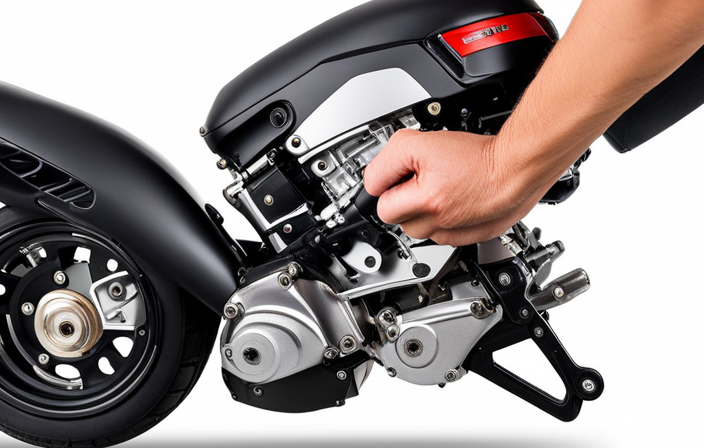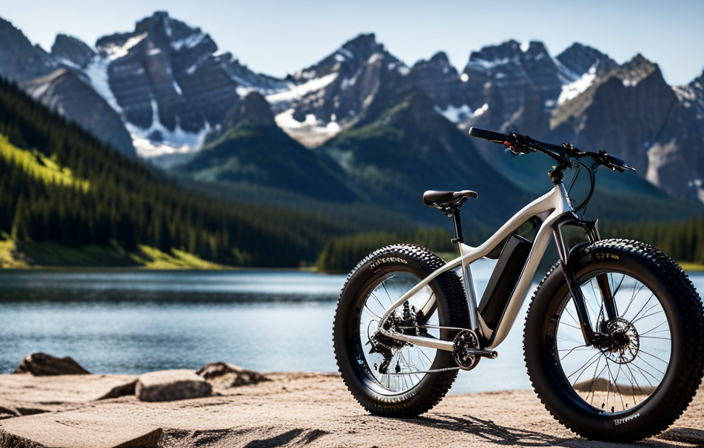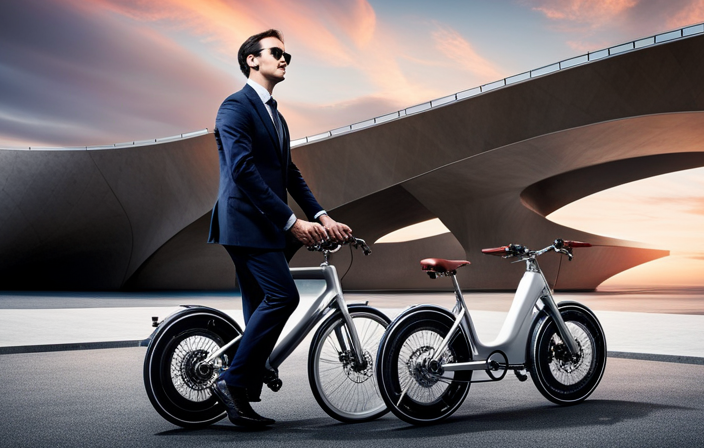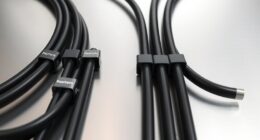I’ve been experiencing a frustrating issue lately with my electric bike losing power during rides.
Picture this: you’re cruising along, enjoying the thrill of the electric assist, when suddenly the bike starts slowing down. It’s a perplexing situation, but fear not!
In this article, we’ll dive into the possible causes and solutions for this power loss. By examining the battery level, wiring connections, motor, and more, we’ll get to the bottom of this issue and ensure our electric bikes are running at their optimal performance.
Key Takeaways
- Throttle inspection and terrain considerations are important factors in diagnosing power loss issues in electric bikes.
- Overheating can significantly affect bike performance and longevity, so proper ventilation and weight management are crucial.
- Reviewing the user manual and consulting with professionals can provide valuable troubleshooting tips and recommendations for improving bike performance.
- Upgrading components such as the battery and tires can enhance power output and overall riding experience.
Check the Battery Level
You should check the battery level to see if that is why your electric bike is losing power. The battery capacity determines how much energy it can store, and if the battery is low, it may not be able to provide enough power to the motor.
To check the battery level, you can refer to the display on your electric bike, which usually indicates the remaining battery percentage. Additionally, consider the charging time of the battery. If you haven’t charged it for a long time, it might be drained and need to be recharged. Insufficient charging time can result in a lower battery capacity, leading to power loss.
Once you have determined the battery level and charging time, you can move on to inspecting the wiring connections to further troubleshoot the issue.
Inspect the Wiring Connections
Inspecting the wiring connections is crucial in troubleshooting the common issues that can cause a loss of power in an electric bike. By following these troubleshooting tips, you can identify potential problems and resolve them efficiently.
Start by visually examining the wiring connections, ensuring that they are securely connected and free from any signs of damage. Look out for loose or frayed wires, as these can disrupt the flow of electricity and lead to power loss. Additionally, check for any corrosion or rust on the connectors, as this can also impede the electrical current.
Once you have thoroughly inspected the wiring connections, you can move on to examining the motor, which is discussed in the subsequent section.
Examine the Motor
To properly troubleshoot the issue, take a closer look at the motor of your electric bike. The motor is a crucial component that can often be the source of common power loss problems.
Start by checking the motor connections to ensure they are secure and free from any damage or corrosion. Loose or faulty connections can disrupt the flow of power and cause performance issues.
Additionally, inspect the motor for any signs of damage, such as overheating or worn-out parts. These can indicate underlying issues that may need to be addressed.
By examining the motor, you can identify and resolve common motor issues that may be causing your electric bike to lose power.
Now, let’s move on to the next troubleshooting tip: cleaning the battery terminals.
Clean the Battery Terminals
Now, it’s time to clean those battery terminals to ensure optimal performance. When it comes to troubleshooting electric bike issues, one common problem is dirty or corroded battery terminals. By cleaning these terminals, you can improve the connection and prevent power loss. Here are some troubleshooting tips and common issues related to battery terminals:
| Troubleshooting Tips | Common Issues |
|---|---|
| Inspect the terminals for dirt or corrosion | Loose connections |
| Use a wire brush to scrub off any dirt or corrosion | Corroded terminals |
| Apply a thin layer of dielectric grease to prevent future corrosion | Dirty terminals |
Test the Charger
After cleaning the battery terminals, it’s important to test the charger to make sure it’s working correctly. Troubleshooting techniques for common charging issues can help identify the root cause of power loss in electric bikes.
To test the charger, start by plugging it into a power source and connecting it to the battery. Ensure that all connections are secure. Observe the charger’s LED lights to check for any abnormal behavior, such as flickering or not turning on at all. Use a multimeter to measure the voltage output from the charger. Compare the measured voltage with the manufacturer’s specifications to determine if the charger is functioning properly. If the charger fails the test, it may need repair or replacement.
Now, let’s move on to checking for tire pressure issues to further troubleshoot power loss.
Check for Tire Pressure Issues
After thoroughly testing the charger and determining it is not the cause of the power loss, it is time to move on to the next potential issue: checking for tire pressure issues. Maintaining proper tire pressure is crucial for optimal performance and efficiency of an electric bike. Incorrect tire pressure can lead to reduced range, decreased traction, and even potential damage to the tires.
To troubleshoot tire issues, follow these steps:
- Check the tire pressure using a pressure gauge
- Compare the measured pressure to the recommended pressure range specified by the manufacturer
- Inflate or deflate the tires accordingly to achieve the appropriate pressure
By ensuring proper tire pressure maintenance, you can enhance your electric bike’s performance and prevent potential tire-related problems.
Now, let’s transition into examining the next area of concern: looking for mechanical problems.
Look for Mechanical Problems
To address any potential mechanical problems, you should start by conducting a thorough inspection of your electric bike. Common signs of mechanical problems in electric bikes include unusual noises, difficulty shifting gears, and excessive vibration. If you notice any of these signs, it is important to troubleshoot the issues promptly to prevent further damage.
Begin by checking the chain and gears for any signs of wear or misalignment. Ensure that the brakes are functioning properly and the brake pads are in good condition. Inspect the tires for any signs of damage or low pressure. Additionally, check the battery connections and wiring for any loose or damaged parts.
By troubleshooting these mechanical issues, you can maintain the optimal performance of your electric bike.
Now, let’s move on to evaluating the controller to further diagnose the problem.
Evaluate the Controller
Once you’ve checked for mechanical problems, evaluating the controller is the next step in diagnosing any issues with your electric bike.
The controller is like the brain of your bike’s electrical system, responsible for regulating the power flow from the battery to the motor.
To troubleshoot the controller, start by inspecting the connections and wiring for any signs of damage or loose connections. Make sure all the wires are securely connected and there are no frayed or exposed wires.
Look for any error codes or warning lights on the controller display. If everything looks fine, you can use a multimeter to test the voltage output from the controller. A faulty controller can often cause power loss in your electric bike.
Now, let’s move on to inspecting the throttle to further diagnose the issue.
Inspect the Throttle
After thoroughly evaluating the controller of my electric bike, it is time to move on to the next potential cause of power loss: the throttle.
The throttle is responsible for regulating the power output of the electric motor, so it is crucial to check its sensitivity and response.
To begin, I will inspect the throttle cable for any signs of damage or wear.
Next, I will test the throttle response by gradually increasing the power output and observing how the motor reacts. If there is a delay or inconsistency in the power delivery, it could indicate a problem with the throttle.
Once I have thoroughly inspected and tested the throttle, I can move on to considering the terrain as a potential factor affecting the power loss.
Consider the Terrain
When evaluating the potential causes of power loss, it is important to consider the terrain. The terrain plays a crucial role in determining the performance of an electric bike. Different terrains require varying levels of power, and certain conditions can affect the overall efficiency of the bike.
It is important to consider the weather when evaluating power loss. For example, strong headwinds or steep inclines can put additional strain on the motor and drain the battery more quickly.
Additionally, evaluating the weight distribution is essential. Uneven weight distribution can impact the bike’s stability and affect its power output.
By considering these factors, you can determine if the terrain is causing the power loss.
Now, let’s move on to the next section and check for overheating.
Check for Overheating
To check for overheating, you should monitor the temperature of the motor and inspect for any signs of excessive heat. Overheating can have detrimental effects on the performance and longevity of your electric bike.
Here are some prevention tips to keep your bike running smoothly:
-
Ensure proper ventilation: Make sure your bike’s motor and battery are adequately ventilated to prevent heat buildup.
-
Avoid excessive loads: Excessive weight or heavy cargo can strain the motor, leading to overheating. Stay within the recommended weight limit.
-
Maintain regular maintenance: Keep your bike clean and free of debris, as dirt and grime can hinder heat dissipation.
By following these prevention tips, you can minimize the risk of overheating and extend the lifespan of your electric bike.
For more detailed instructions and safety guidelines, it’s essential to review the user manual provided by the manufacturer.
Review the User Manual
Make sure you review the user manual for important instructions and safety guidelines.
The user manual provides valuable information on troubleshooting tips and common issues that may arise with your electric bike. It is crucial to familiarize yourself with the manual to understand how to properly operate and maintain your bike.
The manual will guide you through the troubleshooting process, helping you identify and resolve any problems you may encounter. It will also provide you with safety guidelines to ensure your well-being while using the bike.
However, if you are unable to resolve the issue on your own, it is advisable to consult a professional. They have the expertise and knowledge to diagnose and fix any complex problems that may arise with your electric bike.
Consult a Professional
If you’re unsure how to resolve the issue, it’s best to consult a professional. Seeking professional advice and expert consultation can greatly help in diagnosing and resolving the power loss problem with your electric bike. A professional will have the technical knowledge and experience to accurately assess the situation and provide the most appropriate solution. They will be able to identify any underlying issues with the motor, battery, or other components that may be causing the power loss. In order to make the process more enjoyable and relatable, let’s take a look at a table that highlights the benefits of consulting a professional:
| Benefits of Consulting a Professional |
|---|
| Accurate Diagnosis |
| Expert Recommendations |
| Proper Maintenance |
| Enhanced Performance |
Consider Upgrading Components
Consider upgrading the components of your electric bike to improve its overall performance and address any power loss issues you may be experiencing.
One of the key components to consider upgrading is the battery. As batteries age, their capacity to hold a charge decreases, leading to reduced power output. Upgrading to a higher capacity battery can provide a significant boost in performance and extend the range of your electric bike.
Additionally, another component to consider upgrading is the tires. Worn-out tires can cause increased rolling resistance, resulting in reduced efficiency and power loss. By replacing worn tires with ones that offer low rolling resistance and good traction, you can improve the overall performance and power efficiency of your electric bike.
Upgrading these components can greatly enhance your riding experience. However, it is important to also practice proper maintenance to ensure optimal performance and longevity of your electric bike.
Practice Proper Maintenance
After considering upgrading components as a potential solution for my electric bike losing power, it is crucial to understand the importance of proper maintenance.
Regular check-ups and maintenance not only ensure the longevity of the bike but also optimize its performance. By adhering to a maintenance schedule, I can prevent potential issues that may lead to power loss. Proper maintenance benefits include prolonging the life of the battery, maximizing the efficiency of the motor, and reducing the risk of sudden breakdowns.
Regularly checking the tire pressure, cleaning and lubricating the chain, inspecting the brake pads, and ensuring proper battery charging are all essential steps for maintaining the bike’s optimal functionality. Neglecting these regular check-ups can result in decreased power output and potential safety hazards.
Therefore, practicing proper maintenance is crucial to keep my electric bike running smoothly and efficiently.
Frequently Asked Questions
How can I test the charger to see if it’s working properly?
To test the charger’s efficiency, I would first check the battery connections for any loose or damaged wires. Then, using a multimeter, I would measure the voltage output of the charger to ensure it is within the correct range for charging the battery.
What are some common mechanical problems that could cause an electric bike to lose power?
Common mechanical problems that could cause an electric bike to lose power include battery issues, such as low voltage or a faulty connection, and motor problems, such as a worn-out or overheating motor. These issues can significantly impact the performance and power output of the bike.
Is it possible for the throttle to malfunction and cause power loss?
Yes, it is possible for the throttle to malfunction and result in power loss. Throttle sensitivity issues can occur due to wiring problems, faulty sensors, or a need for calibration. Troubleshooting techniques can help identify and resolve these issues.
Can riding in rough terrain affect the performance of an electric bike?
Riding in rough terrain can significantly impact an electric bike’s battery life and cause motor overheating. In fact, studies show that navigating challenging terrains can reduce battery performance by up to 30%.
Are there any specific maintenance tasks I should be doing regularly to prevent power loss in my electric bike?
Regular maintenance and troubleshooting techniques are essential to maintain optimal power in an electric bike. By following recommended maintenance tasks and employing effective troubleshooting techniques, power loss can be prevented and the bike’s performance can be maximized.
Conclusion
In conclusion, troubleshooting and addressing power loss in an electric bike requires a systematic approach. By checking the battery level, inspecting wiring connections, examining the motor, and cleaning the battery terminals, most issues can be resolved. Testing the charger and reviewing the user manual are also important steps to take.
However, if problems persist, it is advisable to consult a professional and consider upgrading components. Proper maintenance is crucial to ensure optimal performance.
Interestingly, a study conducted by the Electric Bike Report found that up to 80% of electric bike performance issues are related to battery problems.









